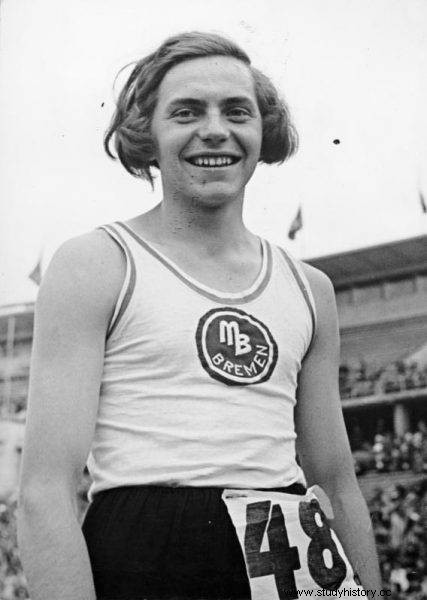Fraud in sports is as old as the sport itself. The thirst for victory, fame and money often pushed the players to do evil deeds. Pharmacological and technical doping, foul play, physical elimination of rivals - these methods are the most common, but not very subtle. In the history of sport, however, there were scammers who took a different path. Here are the disguises, hypocrites and pranksters who have surprised the sports world with their creativity.
September 1938. The Vienna-Cologne express train stops at the Magdeburg station. Alarmed by the conductor, Sergeant Sömmering approaches one of the passengers. Introduces himself and asks for important documents. The woman is looking for them in the bag. At this point, the policeman notices her very hairy hands. Later, he sees the masculine features clearly. Plus it's strange behavior. The conductor's suspicions were probably justified.
Finally, Sömmering receives a pass from the European Athletics Championships, which took place in Vienna a few days ago, with the passenger's name and surname written on it:Dora Ratjen. Three days earlier, this athlete won the gold medal in the aforementioned competition, breaking the world record in women's high jump (1.70 m). The policeman who watches her closely is not sure whether he is talking to a woman or a man. He asks the passenger to pick up her luggage and then drives her to the police station.
Heinrich - athletics champion?
It took only a few minutes of interrogation for Dora, leaning against the wall, to admit that she was indeed a man. Here is his story:he was born in 1918 in Bremen. The midwife delivering the delivery said the Ratjen family had a son, but five minutes later changed her mind. "This is a girl," she said to her father. Then she reported the birth and gender of the child to the relevant offices.
Nine months later, Dora - because that was the name her parents chose for her daughter - fell ill. The father asked the doctor examining her to look at the child's genitals. He said he was dealing with a boy. The confused father decided not to investigate further. In the following years, Dora was raised like a girl. By the time. In 1938 she told the policemen who questioned her:
I wore girly clothes all my childhood. But from the age of 10 or 11, I began to realize that I was not a woman. I never asked my parents why I had to wear women's clothes even though I am a man.
In 1934, she joined the Komet Bremen athletics club, where her sporting abilities were discovered. She started training high jump. The first successes came very quickly:the Lower Saxony championship, the appointment to the Olympic team in 1936.
At the Olympic Games in Berlin in 1936, with a jump of 1.58 m, she placed fourth. Another German, Elfriede Kaun, won. Contrary to popular belief, Hitler and his entourage did not know that Ratjen was a man. Dora hid everything carefully:she shaved her legs, did not swim in the pool, avoided contacts with friends. Friends from the club and the national team later recalled that she never took a shower with them - neither after the competition, nor after training. They said it was probably shyness and did not pursue the subject. Only later did they associate the facts.

Dora hid everything carefully:she shaved her legs, did not swim in the pool, avoided contacts with friends.
After the European Championship, detention and interrogation, shocking news reached Berlin. The Reich Minister of Sports, Hans von Tschammer und Osten, ordered Ratjen to be sent for precise research. The diagnosis was the same:it's a man. The enormous image mishap of the Nazis has become a fact.
The case was quickly silenced and closed in March 1939. Dora was no longer in the papers. Heinrich Ratjen showed up, happy that the time of hiding and lying is over. Little is known about his fate. Apparently he ran a bar in his hometown and died in 2008.
How the "star cousin" tricked the "Saints"
"Hello! This is George Weah. I'd like you to check someone out. This is my cousin. Great footballer, representative of Senegal, former Paris Saint-Germain player. His name is Ali Dia. " Perhaps this was the beginning of a telephone conversation between a mysterious man claiming to be a Golden Ball winner and Southampton F.C coach Graeme Souness. The trainer of the "Saints" agreed and invited the boy for tests. After all, someone like Weah is not denied! Only after some time it will turn out that he did not get a phone call from a Liberian footballer, but from ... Ali's college friend.
Dia came to Southampton to showcase his skills. He previously trained soccer at the Generation Foote academy. He also played in the lower German and French leagues . So he must have been able to do something to convince people from the club playing in the Premier League. Or maybe he just had a better day?
On November 23, 1996, in the 32nd minute of the meeting with Leeds United, Matthew Le Tissier, the "Saints" forward, suffered an injury. He was replaced on the playground by him. Yes, yes - Ali Dia. More minutes passed. Coach Sounessem, teammates and some fans in the stands realized that the new addition to the team was a complete misfire. Said Le Tissier later said that Dia played like "Bambi on Ice". In the 85th minute of the match, the coach couldn't stand it and took Dia off the pitch. It was the end of his career at the highest level.
The club terminated the contract signed with the Senegalese. It also revealed that Dia and his buddy had called several other bands before. Only the "Saints" were deceived in this way. Since then, Ali - an amateur who licked a professional ball for a few minutes - has been winning plebiscites. They are usually started with the adjective "worst".
Disguise - prankster
Let's stay with football. In April 2001, Manchester United faced Bayern Munich. Before the first whistle, English team players lined up for the traditional team photo. Twelve, not eleven players, as usual, posed for the photo. There was a man next to Andy Cole dressed in a "Red Devil" costume. However, he was not a member of the team. His name was Karl Power and he was called by the British "the favorite cheat".
Power blew similar "numbers" a few more times. That same year, he donned the England national team uniform and reported to the cricket ground during the match against Australia. In 2002, at Silverstone, after the British Formula One Grand Prix, wearing a red driver's kit, he stepped onto the podium, just ahead of winner Michael Schumacher. A month earlier, he also did not miss the opportunity to present his tennis skills and tricked his way to the central court during the Wimbledon tournament. Of course, in traditional white clothes.

In 2002, at Silverstone, after the British Formula One Grand Prix, wearing a red driver's kit, he stepped onto the podium, just ahead of winner Michael Schumacher.
All Karl Power actions were a form of a joke and were supposed to keep the fans entertained. A very different mood prevailed among Spanish sports fans in 2000, when the case of Paralympic gold medalists in basketball was brought to light. Scandal? Little to say.
Disabled in the game
In Sydney in 2000, in the final of the Paralympics, the Spanish basketball team beat the Russians. After the final whistle, the feast began on the dance floor. Photojournalists took pictures and the president of the Spanish Federation of Athletes with Intellectual Disabilities, Fernando Martin Vincente, was congratulated. Immediately after the tournament, the union account was credited with EUR 150,000 - this is how much the IOC was paying for gold at that time.
In November 2000, Carlos Ribagorda, a journalist and member of the winning team, released shocking news. In Capital magazine, he wrote:
Out of 200 Spanish athletes in Sydney, at least 15 had no physical or mental impairment . They didn't even undergo medical or psychological examinations.
In addition, when a photo of basketball players celebrating the title was published in the sports magazine "Marc", the editors began to receive messages from people who recognized their friends - by no means having any intellectual difficulties - there. There was a real scandal.
The investigation showed that Vincente was responsible for everything, who had obtained false health certificates for twelve basketball players, table tennis players and swimmers. He also did everything to prevent the Spaniards from getting caught. For example, during the first tournament match with China, when basketball players from the Iberian Peninsula built a 30-point advantage, he instructed the coach to slow down the game of his players. Thus, he dismissed the suspicions.
The scandal ended in court. The guilty were punished and the IOC stripped the masquerade of the title. The Poles benefited from it, who received silver Olympic medals instead of the bronze ones.
Bibliography
- S. Berg, How Dora the Man Competed in the Woman's High Jump , "Spiegel International" (accessed on:28/12/2020).
- R. Stec, The secret of the biggest cheating in the history of the English league, "Wyborcza.pl" (access:28/12/2020).
- M. Filek, Cards from the history of sport , pub. Zysk i S-ka, Poznań 2012.
- G. Tremlett, The cheats , "The Guardian" (accessed on:28/12/2020).
